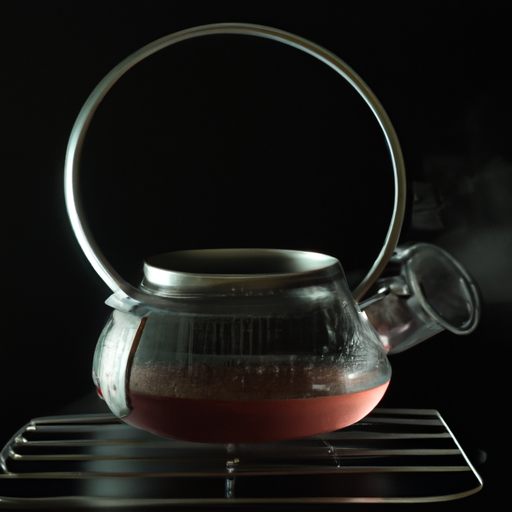I thoroughly enjoy having turmeric tea. It presents a delightful and nutritious method to kick off my day, leaving me rejuvenated with every warm gulp of this amber potion. However, a frequent inquiry is the ideal duration for steeping turmeric tea to enhance its health advantages and perfect its flavor.
Steeping turmeric tea is an essential part of the brewing process. It allows the water to extract all the beneficial compounds from the turmeric root, such as curcumin, which has potent anti-inflammatory and antioxidant properties. However, steeping time can vary depending on your personal preferences and what you want to achieve with your tea.
In this article, I will share everything you need to know about how long to steep turmeric tea for both health benefits and taste, different methods of steeping, adding flavor options, recipes, precautions when drinking it, and other uses for turmeric.
Key Takeaways
- Steeping time for turmeric tea is an essential part of the brewing process and varies based on personal preferences and health goals.
- Factors such as the quality and freshness of turmeric root and the recommended daily intake of turmeric can affect steeping time.
- Water temperature is crucial for optimal extraction of curcumin, with an ideal temperature range of 195°F-205°F (90°C-96°C).
- Enhancements such as adding black pepper, ginger, honey, lemon juice, cinnamon, or herbs like mint or basil can improve taste and provide additional health benefits, while experimenting with fresh vs. dried roots or adding spices can affect taste and health benefits.
Understanding the Steeping Process
When it comes to making a perfect cup of turmeric tea, steeping time is an important factor that can make or break the flavor and benefits of the tea.
There are several factors that affect the steeping time, such as the type and quality of turmeric used, water temperature, and brewing method.
One key factor to keep in mind is the importance of water temperature, as this can greatly impact how quickly or slowly the flavors and nutrients are released from the turmeric.
Factors that Affect Steeping Time
To get the most out of your turmeric tea, you’ll want to consider a few factors that can affect how long it should steep.
First, keep in mind the factors that affect turmeric’s potency, such as the quality and freshness of the root. The fresher and higher quality the turmeric, the more potent it will be.
Second, consider your own health goals and recommended daily intake of turmeric. If you’re consuming turmeric for its anti-inflammatory benefits or other health reasons, you may want to steep your tea for longer to extract more of its beneficial compounds.
In addition to these factors, there are also emotional aspects to consider when brewing your perfect cup of turmeric tea.
For example, taking time to brew a warm cup of tea can provide a sense of comfort and relaxation during stressful times. It can also serve as a reminder to slow down and take care of yourself amidst busy schedules and demanding workloads.
With these important factors in mind, let’s move on to exploring how water temperature plays an equally crucial role in determining the perfect steeping time for your delicious cup of turmeric tea.
Importance of Water Temperature
If you really want to elevate the flavor of your turmeric infusion, pay attention to the water temperature – it’s like finding the perfect note in a symphony.
The importance of water temperature cannot be overstated when it comes to steeping turmeric tea. Water that is too hot can cause the delicate flavors and nutrients in turmeric to break down, while water that is too cold will not extract enough of its beneficial compounds.
To get the most out of your turmeric tea, aim for a water temperature between 195°F and 205°F (90°C-96°C). This range allows for optimal extraction of curcumin, which is responsible for many health benefits associated with turmeric.
Steeping time also plays a crucial role in maximizing these benefits, as longer steeping times result in more curcumin being released from the root. We’ll explore this further in our next section on ‘steeping time for maximum health benefits’.
Steeping Time for Maximum Health Benefits
Steeping turmeric tea for the maximum health benefits is essential, so don’t underestimate the power of a perfectly brewed cup. Turmeric’s active ingredient, curcumin, has been linked to numerous health benefits such as reducing inflammation and improving brain function. However, these benefits can only be fully realized when the turmeric is steeped properly.
To ensure that you are getting the most out of your cup of turmeric tea, it’s important to pay attention to the steeping time. The duration of steeping affects both taste and potency. According to research, steeping turmeric in boiling water for 10-15 minutes releases its full flavor and potency. Steeping for less than 10 minutes may result in a weaker flavor and fewer health benefits.
When it comes to preparing turmeric tea for maximum health benefits beyond steeping time, there are alternative methods worth considering. Some people prefer adding black pepper to their recipe because piperine found in black pepper enhances curcumin absorption by up to 2000%. Others add ginger or honey for added flavor and additional health benefits. Regardless of how you choose to prepare your tea, make sure you’re using high-quality ingredients and following proper brewing techniques for best results.
As we’ve seen, steeping time plays a crucial role in maximizing the potential health benefits of turmeric tea. However, it’s also important not to overlook how this affects taste. In the next section, we’ll discuss how different steeping times can affect not just potency but also taste and aroma – so stay tuned!
Steeping Time for Optimal Taste
You’ll be pleased to know that paying attention to the duration of steeping can also enhance the taste and aroma of your turmeric-infused beverage. Steeping techniques and best brewing practices can make a significant difference in how your turmeric tea tastes.
The optimal time for steeping turmeric tea is around 10-15 minutes, depending on your personal preference. During this time, the turmeric root releases its flavor and natural oils, which infuse into the water along with any other ingredients you may have added.
Over-steeping can cause the tea to become bitter or too strong for some people’s liking. On the other hand, under-steeping may not provide enough flavor or health benefits.
To ensure that you get the most out of your turmeric tea experience, consider experimenting with different brewing methods such as using fresh versus dried roots or adding spices like ginger or cinnamon. These variations will affect both the taste and health benefits of your tea.
In our next section, we’ll explore different methods of steeping turmeric tea so you can find what works best for you.
Different Methods of Steeping Turmeric Tea
When it comes to steeping turmeric tea, I’ve found that there are two main methods that work well for me.
Using tea bags is a convenient option as they come pre-measured and ready to use.
On the other hand, using fresh turmeric root adds a deeper flavor profile to the tea but requires more preparation time.
Both methods offer unique benefits, so it ultimately depends on personal preference and available resources.
Using Tea Bags
If you’re in a rush, pop a turmeric tea bag into your mug and nuke it for a minute to get that warm and cozy feeling. Using tea bags is the quickest and easiest way to make turmeric tea.
Here are some benefits of using turmeric tea bags:
- Convenient: Turmeric tea bags are readily available in most grocery stores and online shops.
- Consistent taste: The amount of turmeric in each bag is measured, ensuring that each cup tastes the same.
- Portable: You can easily bring them with you on trips or to work.
Different types of turmeric tea bags are also available on the market, such as organic, fair-trade, or flavored options. However, be sure to read the label carefully to check if there are any additives or preservatives.
Steeping with fresh turmeric root is another great way to make this healthy drink.
Steeping with Fresh Turmeric Root
Using fresh turmeric root adds a vibrant and earthy flavor to your warm drink. Not only does it taste great, but it also provides numerous health benefits. Turmeric tea is known to aid in reducing inflammation, boosting immunity, and improving digestion.
To brew turmeric tea with fresh roots, start by peeling the roots and grating them into small pieces. Bring water to a boil and add the grated turmeric along with any other desired ingredients such as ginger or honey. Let it simmer for 10-15 minutes before straining the mixture through a fine mesh strainer. For a stronger flavor profile, continue simmering for an additional 5-10 minutes. Remember that longer steep times may result in bitterness, so adjust accordingly based on your preference.
Adding flavor to your turmeric tea can be done in various ways without compromising its health benefits. One way is by adding lemon juice or cinnamon, which not only enhances the taste but also boosts its antioxidant properties. Another option is to infuse the tea with herbs like mint or basil for added freshness.
Experimenting with different ingredients can lead you towards discovering new flavors that suit your palate while still reaping all of the benefits of this powerful spice-infused drink!
Adding Flavor to Your Turmeric Tea
I love experimenting with turmeric tea and adding different flavors to it. Two of my favorite additions are honey and lemon, which give the tea a sweet and citrusy taste.
Another great option is adding cinnamon or ginger, which both complement the earthy flavor of turmeric while adding their own unique taste profiles.
These flavor combinations not only make for a delicious cup of tea, but also offer additional health benefits.
Honey and Lemon
Adding honey and lemon to your turmeric tea is like putting the cherry on top of a sundae – it enhances the flavor and adds an extra punch of health benefits.
Honey is one of the best sweetener options for turmeric tea as it complements the warm, earthy notes of turmeric perfectly. It also has anti-inflammatory properties that can help reduce inflammation in the body, which is especially beneficial for those with arthritis or joint pain.
On the other hand, lemon not only adds a bright citrusy flavor but also provides a good dose of vitamin C. Vitamin C is essential for our immune system as it helps fight off infections and keeps us healthy. Adding a squeeze of lemon to your turmeric tea can also help improve digestion by stimulating digestive enzymes in our stomachs.
Overall, adding honey and lemon to your turmeric tea not only makes it taste better but also brings added health benefits that are worth incorporating into your daily routine.
Speaking of enhancing flavors and adding more health benefits, let’s talk about cinnamon and ginger next!
Cinnamon and Ginger
Ah, cinnamon and ginger – two spices that can transform your daily beverage into a cozy, comforting treat. Adding these spices to your turmeric tea not only enhances its flavor but also provides numerous health benefits.
Here are three reasons why you should consider adding cinnamon and ginger to your next cup of turmeric tea:
-
Cinnamon is known for its anti-inflammatory properties, which can help reduce pain and swelling in the body. It may also help regulate blood sugar levels and improve brain function.
-
Ginger is a great alternative for those who don’t enjoy the taste of turmeric or want to switch up their routine. It’s also an anti-inflammatory spice that may aid digestion, reduce nausea, and lower cholesterol levels.
-
Both cinnamon and ginger contain antioxidants that can protect against cell damage caused by free radicals.
If you’re looking for a way to make your turmeric tea even more delicious, adding cinnamon and ginger is a great option. Not only do they add a warm spice flavor, but they also provide numerous health benefits.
Now let’s dive into some tasty turmeric tea recipes!
Turmeric Tea Recipes
To make a delicious cup of turmeric tea, you’ll need to gather your ingredients and follow one of these simple recipes. Turmeric tea is known for its numerous health benefits, including reducing inflammation and boosting the immune system.
One popular recipe is to simmer a cup of water with half a teaspoon each of ground turmeric and ginger for 5-10 minutes, then strain and add honey or lemon juice to taste. Another variation includes adding cinnamon or cardamom for added flavor. You can also experiment with different milk alternatives like almond or coconut milk to create a creamy texture.
Turmeric tea can be enjoyed hot or cold, making it a versatile beverage choice all year round. And if you’re looking for other uses for turmeric beyond just drinking it as tea, keep reading!
There are many ways to incorporate this powerful spice into your daily routine, from adding it to smoothies or curries to using it topically as a natural skin brightener.
Other Uses for Turmeric
I want to talk about the other uses for turmeric beyond making tea. Turmeric is a versatile spice that has both culinary and medicinal uses.
When used in cooking, it adds a warm, earthy flavor and can be used in a variety of dishes from curries to smoothies.
In addition, turmeric has been used for centuries in traditional medicine to treat inflammation, digestive issues, and even depression.
Culinary Uses
Turmeric is a versatile spice that can add a unique flavor and color to many dishes. It’s commonly used in curries, soups, and stews, but it can also be added to smoothies for an extra boost of health benefits.
One great way to incorporate turmeric into your diet is by making turmeric tea. Not only does it taste delicious, but it also has many health benefits. Turmeric tea has been shown to have anti-inflammatory properties and may help improve brain function.
To make turmeric tea, simply boil water and add fresh or ground turmeric root. You can also add other spices like ginger or cinnamon for added flavor and health benefits. There are endless variations of turmeric tea recipes available online, so experiment with different ingredients until you find the perfect combination for you.
As we move on to discussing the medicinal uses of turmeric, it’s important to note that while culinary uses of this spice are enjoyable and beneficial on their own, there are even more health benefits when using turmeric as medicine rather than just as a seasoning in food.
Medicinal Uses
As we discussed earlier, turmeric is a versatile spice that has many culinary uses. However, beyond its flavor-enhancing properties, turmeric also has numerous medicinal benefits. One of the most popular ways to consume turmeric for its health benefits is by drinking turmeric tea.
Turmeric tea has been shown to have anti-inflammatory properties due to the presence of curcumin, a compound found in turmeric. Inflammation is a common underlying factor in many chronic diseases such as arthritis and heart disease, making turmeric tea an excellent addition to one’s diet for overall health and wellness.
Additionally, drinking turmeric tea may aid in digestion by reducing bloating and improving gut health.
- Drinking turmeric tea can help reduce inflammation naturally.
- Turmeric tea can be used as an alternative remedy for chronic pain.
- Regular consumption of turmeric tea may support healthy digestion.
- Turmeric tea can be made easily at home using simple ingredients.
If you’re looking for a natural way to improve your overall well-being, incorporating turmeric tea into your daily routine may be worth considering. However, it’s important to note that there are precautions that should be taken when consuming this beverage. Let’s take a closer look at some of these precautions in the following section.
Precautions When Drinking Turmeric Tea
Before taking a sip of your freshly brewed turmeric tea, remember that "an ounce of prevention is worth a pound of cure."While turmeric has many health benefits, it’s important to take precautions when drinking the tea.
Here are some things to keep in mind:
-
Firstly, be mindful of the dosage. Turmeric contains curcumin, which can have adverse effects if consumed in large amounts. It’s generally safe to consume up to 3 grams per day, but exceeding this amount can lead to gastrointestinal issues such as nausea or diarrhea.
-
Secondly, consider any medication you may be taking. Turmeric has blood-thinning properties and can interact with certain medications like aspirin or warfarin. If you’re on medication or have any underlying medical conditions, it’s best to consult with your doctor before consuming turmeric or turmeric-containing products.
-
Lastly, make sure you’re using quality ingredients when preparing your tea. Choose fresh organic turmeric root whenever possible and avoid using processed powders that may contain additives or preservatives. Also, ensure that the water used is clean and free from contaminants.
By taking these precautions when drinking turmeric tea, you can safely reap its many health benefits while minimizing potential risks. Remember to always listen to your body and seek professional advice if needed.
Frequently Asked Questions
Can I reuse the turmeric tea bag or should I always use a fresh one?
When it comes to reusing tea bags, it really depends on your personal flavor preferences. Some people prefer to use a fresh tea bag each time they make tea, while others are perfectly content with reusing the same bag multiple times.
If you do choose to reuse a turmeric tea bag, keep in mind that the flavor may not be as strong as when using a fresh one. It’s also important to note that some types of tea should never be reused due to potential health risks, but turmeric tea is generally considered safe for reuse.
Ultimately, the decision to reuse a tea bag or not comes down to personal preference and taste.
Does the temperature of the water affect the steeping process for turmeric tea?
Water temperature can have a significant impact on the steeping process for turmeric tea. Just like how a chef must carefully monitor the temperature of their pan when cooking, the temperature of the water used to brew turmeric tea can greatly affect its flavor and potency.
Steeping time variations can also be impacted by water temperature, as hotter water may require less time to fully extract all of the beneficial compounds from the turmeric root. In my experience, using water that’s around 205°F (96°C) and steeping for 5-10 minutes is optimal for producing a flavorful and effective cup of turmeric tea.
However, it’s important to experiment with different temperatures and steeping times to find what works best for your personal preferences and desired health benefits.
How much turmeric should I use per cup of water when making turmeric tea?
When making turmeric tea, I typically use about 1 to 2 teaspoons of ground turmeric per cup of water. However, this can vary depending on personal taste preferences and the desired strength of the tea.
Turmeric tea is a great way to incorporate the many health benefits of turmeric into your daily routine, such as reducing inflammation and improving digestion. There are also many variations and recipes for turmeric tea, including adding ginger or honey for added flavor and health benefits.
So, experiment with different amounts and variations until you find your perfect cup of turmeric tea!
Can I add honey or other sweeteners to my turmeric tea?
Yes, I personally enjoy adding honey to my turmeric tea for a touch of sweetness. Some people may prefer other honey alternatives like maple syrup or agave nectar.
When making turmeric tea, it’s important to use the right amount of turmeric per cup of water. Generally, one teaspoon of ground turmeric is sufficient for one cup of water.
There are also numerous turmeric tea recipes available online that incorporate different spices and flavors to suit your taste preferences. While steeping time can vary based on personal preference, most recommend steeping for at least 10 minutes to allow the full flavor and health benefits of the turmeric to develop in the tea.
Can I drink turmeric tea every day or are there any potential health risks associated with consuming it regularly?
I drink turmeric tea every day and haven’t experienced any negative health effects. In fact, there are many benefits of turmeric tea that make it a great addition to my daily routine.
Turmeric is known for its anti-inflammatory properties, which can help reduce joint pain and inflammation in the body. It also contains antioxidants that may help protect against certain diseases and support overall health.
The recommended daily intake of turmeric tea varies depending on factors such as age, weight, and overall health status, but generally 1-2 cups per day is considered safe for most people.
It’s important to note that while turmeric is generally safe to consume in food or supplement form, high doses or long-term use may cause gastrointestinal issues or interact with certain medications. As always, it’s best to consult with a healthcare provider before adding any new supplements or foods to your diet.
Conclusion
Well folks, there you have it – steeping turmeric tea is an art form that requires patience and precision. But the rewards are worth it!
Whether you’re looking to reap the health benefits of this superfood or simply savor its delicious taste, knowing how long to steep your turmeric tea is key. So go ahead and experiment with different steeping times and methods until you find what works best for you.
And don’t forget to spice things up by adding other flavors like ginger, cinnamon, or honey. With a little creativity and a lot of love, your homemade turmeric tea will be the envy of all your friends.
So grab a mug, take a deep breath, and enjoy the warm embrace of this golden elixir. Cheers!










